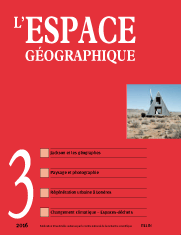

Jean-Marc BESSE. John Brinckerhoff Jackson, geography and vernacular landscape
Jean-Marc BESSE. Founding landscape studies: John Brinckerhoff Jackson and French human geography (2 encadrés; 3 photos)
This paper aims at studying the relationship between the famous historian of the American landscape, John Brinckerhoff Jackson, and French human geography, just as he created Landscape, which would become in the 1950s a journal of reference in the field. The article begins with how Jackson discovered French human geography and how the field inspired him as he was developing his personal landscape theory. It goes on to describe his work method, based on his archives and library.
keyword: JEAN BRUNHES, HUMAN GEOGRAPHY, JOHN BRINCKERHOFF JACKSON, LANDSCAPE, LANDSCAPE ARCHITECTURE
(10 photos)
Though John Brinckerhoff Jackson (1909-1996) was pivotal in the birth and development of American landscape studies, few works have been published to date on his manner of approaching the world and producing knowledge. Without a doubt, his writings, in all their various forms, inform the on-site elaboration of his field experiences. However, it is only by understanding his photographic practices that we can discover how he traveled, observed, and inquired on the field, during three decades. Composed of five thousands slides, his photographic archives help better understand his approach to research, which he defined as amateur.
keyword: AMATEUR, FIELD, JOHN BRINCKERHOFF JACKSON, LANDSCAPE, ORDINARY, PHOTOGRAPHY
John Brinckerhoff Jackson. Commencement ceremony speech. UC Berkeley’s Department of Geography, May 1986, unpublished text presented and translated by J. Ballesta (1 document)
After regularly teaching at the UC Berkeley Department of Geography and building durable scientific relationships with it, John Brinckerhoff Jackson was invited to give the commencement speech in 1986. He had written his speech out beforehand, planning to describe his conception of geography, as he personally practiced it and defined it as a specific research field. In so doing, he defended a relational and empiric geography, based on the curiosity of the amateur and on the study of the most ordinary ways of dwelling.
keyword: AMATEUR CULTURE, DIFFUSION OF KNOWLEDGE, GEOGRAPHY, LANDSCAPE ARCHITECTURE, ORDINARY LANDSCAPE
(1 encadré; 3 fig.; 5 tabl.)
Using newspaper sources to measure protest activity requires to critically assess the specificities that determine the production of media information. Using research on oppositions to urban regeneration policies in London since the late 1990s, we show how media sources were used to track the expansion of antiregeneration protests. In doing so, we highlight framing effects used by the local press, in particular geographical framing, that contribute to redefining the outline of regeneration as a public issue.
keywords: GOVERNANCE, MEDIA, PLANNING CONFLICT, URBAN REGENERATION
Climate change and regional daily press: Which representations in Sud Ouest (1995-2010)? (2 fig.; 3 tabl.)
In the midst of growing calls to action on climate change at all scales, little is really known about the way in which this worldwide phenomenon is represented at a local level. This paper offers a glimpse through the analysis of articles published in a local newspaper Sud Ouest. The articles were selected based on a single criterion – they had to contain the words “climate change”. The study reveals an unending cycle of discourses. Until 2006, a large portion of coverage was dedicated to international negotiations and their repeated failures. Beginning in 2007, the focus gradually shifted to more local forms of action. This change illustrates growing local interest in climate change, which was supported by regional newspapers.
keywords: CLIMATE CHANGE, DAILY PRESS, DISCOURSE, ENVIRONMENT, SUD OUEST
(1 fig.; 4 photos; 1 tabl.)
Space and demography offer a less constraining ratio in the Americas than in other continents. Since the colonial period, exploitation has dominated the relationship to territories considered “disposable”. The system produced waste-spaces that are currently at the heart of debates on the scarcity of resources, despite being little known and studied. In order to demonstrate that models of territorial development are equally informed by waste-spaces and productive systems, this paper establishes the methodological and theoretical framework for a regional approach. It defines these spaces as consubstantial to globalization, and shows their transformation in space and time.
keywords: AMERICA, ENVIRONMENT, SPATIAL SYSTEM, WASTE, WIDE-OPEN SPACES</p>
Pascal CLERC. Indian Ocean (2 photos)
Book reviews
In this issue of l’Espace géographique, you will find critical reviews of the following books
MÉAUX D. (2015). Géo-photographies. Une approche renouvelée des territoires. Bruxelles: Filigranes Éditions, 176 p. (Didier Mendibil, équipe EHGO, Umr 8504 Géographie-cités) ISBN: 978-2-35046-358-2
DEBARBIEUX B. (2015). L’Espace de l’imaginaire. Essais et détours. Paris: CNRS Éditions, 305 p. (François Walter, université de Genève) ISBN: 978-2-271-08824-6
DESSE R.-P., LESTRADE S. (dir.)(2016). Mutations de l’espace marchand. Rennes: Presses universitaires de Rennes, coll. «Espace et territoires», 414 p. (Guy Baudelle, université de Rennes 2) ISBN: 978-2-7535-4899-2
GLON É., PECQUEUR B. (2016). Au cœur des territoires créatifs. Proximités et ressources territoriales. Rennes: Presses universitaires de Rennes, coll. «Espace et territoires», 296 p. (Guy Baudelle, université de Rennes 2) ISBN: 978-2-7535-4951-7
L’espace géographique 2/16![]()
![]() L’espace géographique 4/16
L’espace géographique 4/16
For subscribe or buy this issue: BELIN
![]() L’Espace géographique: contents
L’Espace géographique: contents
Last modified: July 6, 2016